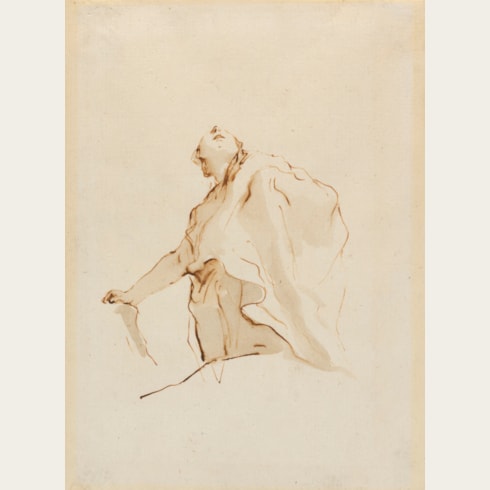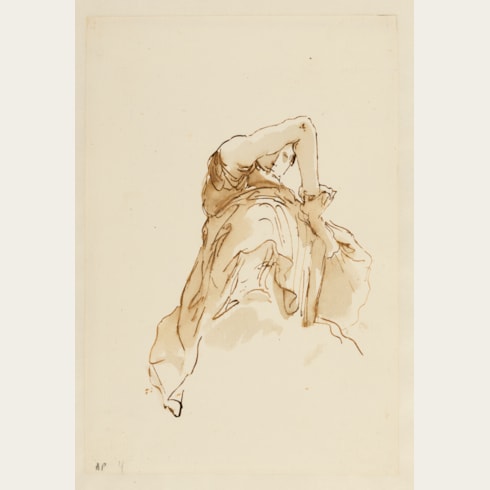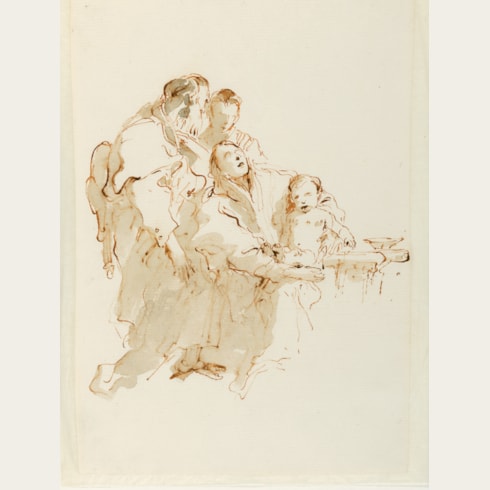Giovanni Battista TIEPOLO
(Venice 1696 - Madrid 1770)
A Study for a Ceiling: A Seated Figure on a Cloud
186 x 134 mm. (7 3/8 x 5 1/4 in.)
The same novel approach to viewpoint and perspective is also evident in many of Tiepolo’s spirited drawings for ceiling figures, of which the present sheet is a fine example. As has been noted of the drawings from the Sole figure per soffiti albums, ‘These sheets depict individual foreshortened figures - ethereal young women, heroic nudes, and warriors – as well as figures that are so sharply foreshortened that only their knees, parts of their heads, and perhaps one or both of their arms can be seen.’ The confidence and ingenuity evident in the composition of a drawing such as the present sheet is a feature of Tiepolo’s draughtsmanship that has long been esteemed. As Marjorie Cohn has written, ‘No student of Tiepolo drawings remains indifferent to their sheer virtuosity. Giambattista, in his wash drawings above all, achieved a new abstraction of illusionism through physical means that were direct, immaculate, and apparently effortless.’
Comparable studies of figures seen from below, characterized by a particular emphasis on the dangling legs of a seated figure, include drawings in the collections of the Albertina in Vienna, the Museo Civico Sartorio in Trieste, the Fitzwilliam Museum in Cambridge, the Musée des Beaux-Arts in Rouen, the Kupferstichkabinett in Berlin, the Museum Boijmans van Beuningen in Rotterdam and the Graphische Sammlung of the Staatsgalerie in Stuttgart, as well as several drawings in the Princeton University Art Museum.
The leading painter in Venice for much of his career, Giambattista Tiepolo was also undoubtedly one of the finest Italian draughtsmen of the 18th century. That his drawings were greatly admired in his lifetime is confirmed by contemporary accounts; indeed, as early as 1732 the writer Vincenzo da Canal remarked that ‘engravers and copyists are eager to copy his works, to glean his inventions and extraordinary ideas; his drawings are already so highly esteemed that books of them are sent to the most distant countries’. From the late 1730’s until his departure for Spain in 1762, Tiepolo enjoyed his most productive period as a draughtsman, creating a large number of vibrant pen and wash studies that are among the archetypal drawings of the Venetian Settecento. As one recent scholar has commented, ‘From the start of his career [Tiepolo] had enjoyed drawing as an additional means of expression, with equally original results. He did not draw simply to make an immediate note of his ideas, nor to make an initial sketch for a painting or to study details; he drew to give the freest, most complete expression to his genius. His drawings can be considered as an autonomous artistic genre; they constitute an enormous part of his work, giving expression to a quite extraordinary excursion of the imagination; in this respect, Tiepolo’s graphic work can be compared only with that of Rembrandt.’
Tiepolo’s drawings include compositional studies for paintings and prints, drawings of heads, figure studies for large-scale decorations, landscapes and caricatures, as well as several series of drawings on such themes as the Holy Family. Many of these drawings were bound into albums by theme or subject, and retained by the artist in his studio as a stock of motifs and ideas for use in his own work, or that of his sons and assistants.
Provenance
Literature
Exhibition


























